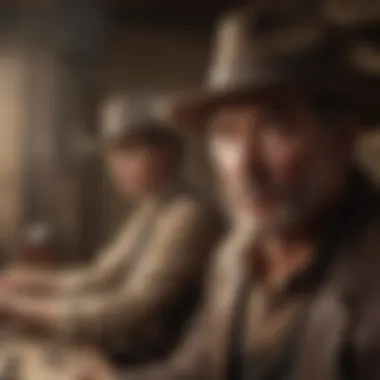The Cultural Impact of Gunsmoke Radio in America


Intro
Gunsmoke Radio holds a significant place in American cultural history, characterized by its innovative storytelling and distinct narrative style. First aired in 1952, the show captivated audiences with its portrayal of life in the American West. The radio program was not merely a source of entertainment; it served as a lens through which listeners could explore their own realities and societal norms of the time. With its rich characters and intricate plots, Gunsmoke paved the way for the Western genre, influencing countless adaptations and interpretations across media platforms.
This narrative delves into the many facets of Gunsmoke Radio, examining its historical context, the evolution of its storytelling techniques, and its lasting legacy on contemporary audio dramas. As we explore these aspects, we will also highlight how Gunsmoke Radio contributed to shaping American culture and identity. By analyzing character development, themes, and cultural implications, the discussion aims to provide a comprehensive understanding of the lasting impact of this iconic radio show on the entertainment landscape.
Artist Profile
Biography and Background
Gunsmoke was created by Norman Macdonnell and written for radio by John Meston. It began as a half-hour show on CBS, evolving from the original concept of short stories set in Dodge City, Kansas. With a strong focus on character and dialogue, the show became known for its authenticity in depicting the challenges and struggles of its characters, particularly its protagonist, Marshal Matt Dillon, voiced by William Conrad.
The show's production was a collaborative effort, gathering talented individuals who contributed to its success. The cast included notable actors, such as Parley Baer, who played Chester Proudfoot, and Amanda Blake, who portrayed Miss Kitty Russell. Each brought depth to their roles, further enhancing the narrative's impact on listeners.
Major Influences and Inspirations
The creative direction of Gunsmoke was influenced by various literary works and Western mythology. The tales of the Old West, especially those depicting lawmen and outlaws, informed the show’s storylines. Additionally, Meston and Macdonnell drew inspiration from the pressures of post-World War II America, which prompted listeners to look for heroes, justice, and morality in their entertainment.
Preface to Gunsmoke Radio
Gunsmoke Radio occupies a significant place in the annals of American broadcasting history. It is more than just a radio show; it is a cultural artifact that reflects the values, struggles, and aspirations of its time. The program showcases the adventurous spirit associated with the American West, offering listeners a glimpse into a world marked by both heroism and moral ambiguity.
The importance of understanding Gunsmoke lies in its ability to connect audiences with historical themes and cultural narratives. As a radio drama, it had a unique impact on storytelling techniques. The show maintained a dedicated following during its original airing from 1952 to 1961. It became a touchstone for Western genre enthusiasts and a blueprint for future audio storytelling.
Historical Context
To grasp the significance of Gunsmoke, it is essential to consider the historical backdrop of the time. The early to mid-twentieth century was a period of transformation in America. Post-World War II, families gathered around their radios for entertainment, often craving heroes and myths that the Western genre provided. Gunsmoke emerged during this time, catering to an audience eager for narratives that embodied rugged individualism.
The creators of Gunsmoke were aware of the social fabric of the audience. They wove in complex themes of morality, justice, and the grim realities of frontier life. This framework not only entertained but also sparked discussions about societal values. Thus, Gunsmoke serves as both a mirror and a lens through which to understand American culture in that era.
The Birth of a Cultural Icon
The inception of Gunsmoke marked the beginning of a new era in radio drama. Its development involved a meticulous blend of storytelling, sound design, and character arcs that resonated deeply with listeners. The character of Marshal Matt Dillon, portrayed by William Conrad, became an archetype in American culture. He embodied strength, fairness, and a relentless pursuit of justice, attributes that audiences admired during times of uncertainty.
Moreover, the show’s storytelling structure set a new standard for radio dramas. Each episode built upon prior narratives, engaging audiences with both standalone stories and overarching plotlines. This depth allowed Gunsmoke to transcend the limitations often found in other radio programs, contributing to its status as a cultural icon.
Through its rich narrative and complex characters, Gunsmoke Radio not only entertained but also shaped the landscape of American entertainment. Its legacy is felt even today, influencing modern storytelling across various mediums.
The Format of Gunsmoke Radio
The structure and aural choices that defined the Gunsmoke radio show were integral to its popularity and lasting influence. The format operated not only as a method of storytelling but also as a vital component in connecting with audiences. Understanding how this format was executed opens a window into the elements that made the show exceptional and how it established a standard for future radio dramas.
Episode Structure
The typical structure of a Gunsmoke episode was carefully designed to maximize dramatic impact and audience engagement. Each episode typically unfolded within a 30-minute timeframe. This brevity ensured that narratives remained tight and focused, avoiding unnecessary digressions. Episodes often began with a compelling hook. This might be a captivating line or a sound that drew listeners in immediately. Then, the story would develop, presenting conflicts that reflected the societal challenges of the time.
The narrative often centered around themes of justice, morality, and survival, common in the Western genre. Episodes were typically resolved within their own arcs, providing closure for each story. This helped maintain listeners' attention week after week, as they anticipated both resolution and continuity. Additionally, a cliffhanger might occasionally be used, leaving some aspects unresolved, which contributed to audience engagement over multiple episodes.
Sound Design and Effects
Sound design in Gunsmoke was a crucial part of the listening experience. The clever use of sound effects helped create vivid images in the minds of the audience. For example, the sound of horses galloping or gunfire transported listeners directly into the heart of the action, creating an immersive experience. Each sound was precisely timed within the dialogue, enhancing the storytelling.
Voice actors played an essential role, using tonal nuances to convey complex emotions and character depth. The quality of voice work added a significant layer to character development, making heroes and villains memorable.
In addition to traditional sound effects, background noises like saloon chatter, nature sounds, and town ambience helped create a realistic setting that was crucial for a show set in the American West. These audio elements worked together to form a cohesive atmosphere that drew in listeners, offering them an auditory glimpse into a world far removed from their everyday lives.
Exceptional audio storytelling like that in Gunsmoke played an essential role in shaping how future radio dramas approached sound design.
Through the combination of well-structured episodes and innovative sound design, Gunsmoke left an indelible mark on American culture, illustrating the profound impact of audio storytelling.
Character Development in Gunsmoke
Character development serves as an essential artery in the fabric of Gunsmoke, intertwining the auditory experience with complex human emotions and moral dilemmas. At its core, this radio drama captured not merely the story of the Wild West but also the psychological depth of its characters. The effective portrayal of individuals struggling with choices reflects broader societal values and challenges. This subsection delves into the various facets of character development within Gunsmoke, emphasizing how it was not just a narrative device but a means of engaging listeners on multiple levels.
Main Characters
The main characters of Gunsmoke are multidimensional, contributing significantly to the narrative’s richness. Matt Dillon, the town's marshal, exemplifies the archetype of law and order but also reveals vulnerability. His struggles with the dualities of justice and personal morality engage the audience deeply. Another central figure, Kitty Russell, the saloon owner, challenges the gender norms of the era and adds layers to themes of independence and survival. Additionally, Doc Adams introduces a moral compass through his medical practice, demonstrating compassion in a harsh world.
Each character's growth aligns with the show's overarching themes. For instance, Matt's evolution reflects his grappling with justice in a lawless land. Over the series, listeners witness how his character navigates personal loss and professional responsibility, providing a basis for understanding broader human conditions. Notably, the dialogue reveals their intricacies. Each interaction, often punctuated by tension or camaraderie, further advances their development and the audience's connection to them.
Supporting Cast
The supporting cast is crucial in shaping the narrative and enhancing the main characters' arcs. Figures like Chester Proudfoot, Matt's trusted deputy, add levity and exemplify loyalty, while contrasting Matt's serious demeanor. Characters such as Miss Kitty amplify themes of survival and resilience, each offering a unique worldview within the context of the frontier.
Moreover, numerous guest stars bring diverse stories, broadening the show's horizons. Their roles often challenge societal norms or present ethical dilemmas. For instance, when a former outlaw appears seeking redemption, it tests the convictions of main characters and interrogates the idea of second chances in a brutal world.
Through these interactions and relationships, Gunsmoke is not merely a collection of tales; it transforms into a commentary on community, identity, and moral complexity. The depth of character development keeps listeners engaged, making it a lasting cultural artifact.
"It is the characters' conflicts that resonate, reflecting both individual struggles and collective societal dilemmas in a rapidly changing America."
The deliberate crafting of each persona serves not just to entertain but to provoke thought, inviting listeners to reflect on their own principles and experiences.
Themes Explored in Gunsmoke Radio


Gunsmoke Radio is more than just a source of entertainment; it is a reflection of deeper societal themes that resonate with the American experience. Through its stories and characters, the show explores ideas of justice, morality, and the essence of the frontier. This exploration elevates the show from mere storytelling to a cultural artifact that provides insight into historical and social dynamics. The themes serve not only as a narrative backbone but also as tools for understanding the complexities of human behavior in the context of American values.
Justice and Morality
The theme of justice in Gunsmoke Radio is prevalent throughout. It often explores what justice means in a world where law is not always clear-cut. Characters like Marshal Matt Dillon embody a personal moral code that sometimes conflicts with legal statutes. This dilemma reflects broader societal questions about right and wrong in an imperfect world. The characters often face situations where the law fails to deliver justice, prompting them to take matters into their own hands.
This theme is of great significance, as it depicts the continual struggle between individual ethics and societal expectations. The audience engages with these moral quandaries, questioning whether the characters' actions are justified. This notion encourages listeners to ponder their own values and the implications of those values in their daily lives. Issues like revenge, redemption, and the pursuit of fairness are intricately woven into the narrative fabric of each episode.
The Frontier Myth
Another vital theme in Gunsmoke Radio is the Frontier Myth. The American frontier symbolizes the untamed challenges and opportunities that define much of the national identity. Gunsmoke encapsulates the essence of this myth by portraying the struggles of characters who navigate a world that is both harsh and beautiful.
The frontier serves as a backdrop for discussions of resilience, independence, and survival. It challenges characters to adapt and showcase their strengths. This setting does not merely serve as a stage but actively shapes the characters' development and decisions. The exploration of this theme engages listeners' imaginations and invokes a sense of longing for adventure, self-discovery, and the exploration of unknown territories.
Cultural Impact of Gunsmoke
The cultural impact of Gunsmoke is profound and multifaceted. This radio drama not only entertained millions but also shaped perceptions of the American West. As a result, Gunsmoke developed a loyal audience that resonated with its themes and characters. The series, which began airing in 1952, became a cornerstone of American radio and later television, influencing the entertainment landscape in various ways.
Influence on the Western Genre
Gunsmoke played a pivotal role in defining the Western genre. Before its debut, Westerns were often portrayed as simplistic tales of good versus evil. However, Gunsmoke introduced complex characters and moral ambiguity. The series depicted lawmen like Marshal Matt Dillon as deeply human, struggling with their duties while navigating a lawless environment. This complexity drew audiences in and set a new standard for storytelling.
The show portrayed not only heroic figures but also villains with depth. The characters of Gunsmoke wielded their guns not just for a show of force but often out of necessity or as a struggle for survival. This shift offered a more nuanced view of life in the American frontier and appealed to a generation craving authenticity in storytelling. Furthermore, Gunsmoke influenced subsequent Westerns in both radio and film, establishing a template that many would follow.
Gunsmoke's Legacy in Modern Media
The legacy of Gunsmoke endures in contemporary media. Its blend of character-driven stories and robust moral questions can be seen in modern television dramas. Productions such as Deadwood and Justified draw inspiration from the archetypes and narrative styles established by Gunsmoke. Furthermore, the show's emphasis on sound design and storytelling paved the way for many audio dramas that followed.
"Gunsmoke's intricate storytelling and complex characters were a radical departure from the formulas typically seen in early radio dramas."
In addition, Gunsmoke has contributed to the preservation of audio storytelling. By reminding audiences of the power of sound, this series helped keep the format relevant. Artists today still cite Gunsmoke as an example of how audio can engage listeners without visual aid.
The show's influence can also be traced in merchandise and references found in popular culture. From video games to comic books, Gunsmoke has left an indelible mark that continues to be explored and reimagined in various forms. The series stands as a testament to the evolving nature of storytelling and its ability to reflect the culture of its time.
Transition from Radio to Television
The transition of Gunsmoke from radio to television marked a significant evolution in not just its narrative arc but also in American media consumption. This shift held relevance for various reasons, including the change in audience engagement, technological advancements, and the evolving nature of storytelling.
Adapting Narratives
When Gunsmoke moved to television in 1955, the creative team faced the challenge of reinterpreting stories that had thrived on the auditory imagination of radio listeners. In a radio setting, sound was the primary means to engage the audience. Without visual cues, character development relied heavily on dialogue and sound effects. In the TV adaptation, however, writers had to integrate visual storytelling, thus creating a more immersive experience.
The characters of Marshal Matt Dillon, Kitty Russell, and Doc Adams were adapted to have a more visually dynamic presence. The narrative shifted to visual action sequences, often incorporating complex interactions with the environment, which was impossible in the audio-only format. As a result, audience understanding broadened, allowing viewers to form a deeper connection with the characters through physicality and presence.
Visual Storytelling Innovations
Visual storytelling in Gunsmoke highlighted the contrasts between radio's suggestive storytelling and the definitive imagery offered by television. It introduced a range of innovations in depicting conflict and emotional depth. Cinematic techniques such as close-ups helped to capture character frustrations or triumphs, enriching the narrative in ways that auditory storytelling alone could not.
In terms of production, the use of color in the television adaptation elevated the visual experience. Viewers could appreciate the dusty landscapes of the Old West in vivid hues, bringing a layer of authenticity and aesthetic appeal to the storytelling. Furthermore, techniques like establishing shots provided context about the surroundings and scale of the narrative, thereby allowing the audience to immerse themselves in the rugged life of Dodge City with more clarity and immediacy.
"The transition illuminated the inherent strengths of both formats—radio's capacity to evoke imagination and television's ability to portray vivid realities."
The balance of these elements allowed Gunsmoke to not only retain its core narratives from the radio program but also evolve them to fit modern expectations. In doing so, it set a precedent for how adaptations of audio stories can succeed in the visual landscape while capturing the hearts and minds of a new generation of audiences.
Critical Reception
The critical reception of Gunsmoke Radio is significant as it reflects the wider cultural conversations of its time and provides insight into the evolving standards of storytelling. Critics have engaged with Gunsmoke not just as a piece of entertainment, but as a cultural artifact. They evaluated its themes, characters, and overall narrative structure while also contemplating its reflections on American society during the mid-20th century.
The importance of understanding critical reception lies in its ability to measure the impact of the show on its audience and the media landscape. Over the years, assessment from both critics and audiences has demonstrated how Gunsmoke resonated with the societal issues of the era, such as justice, morality, and the complexities of human behavior.
This analysis helps us comprehend why Gunsmoke maintained its popularity for decades, leading to a lasting legacy in arts and media. When Gunsmoke ended its radio run, it had become synonymous with the Western genre—an indication of its powerful reception.
Audience Response
Gunsmoke's audience response was overwhelmingly positive, establishing a dedicated following across the United States. Listeners tuned in weekly, forming a collective experience that added depth to the engagement with the content. The show became a pivotal part of weekday nights for many families, serving as a shared cultural reference.
- Engagement: The serialized format allowed audiences to invest emotionally in the characters and story arcs. Each episode left listeners eagerly anticipating the next chapter in Matt Dillon’s life.
- Surveys and Feedback: Surveys conducted during its airing period indicated that the audience appreciated the moral dilemmas faced by the characters. The authenticity in dialogue and storytelling helped the show feel relatable.
As importantly, listener letters and fan clubs emerged, indicating that Gunsmoke fostered an active community where fans expressed their support and critiques. This interaction provided producers with valuable insights and showed a two-way engagement seldom seen at that time.
Critical Analysis Over Time
The critical analysis of Gunsmoke has evolved over time, reflecting changes in societal values and media critique methodologies. Early reviews largely praised the show for its strong character development and realistic portrayals of life in the American West. Critics noted the dynamic between law and disorder depicted in the series, which mirrored ongoing national issues regarding justice and morality.
- Shifts in Perspective: Over the decades, scholars and media critics revisited the series with different lenses, including feminist and post-colonial critiques. They explored the representation of gender roles and the treatment of indigenous characters, leading to broader discussions about media responsibility and portrayal.
- Academic Interest: Gunsmoke has not only been analyzed as a popular show, but also as a case study in media and cultural studies programs. Many researchers have published papers focusing on its narrative structure, thematic depth, and the impact of audio storytelling.
All these factors contribute to Gunsmoke's critical legacy. It is a case of a radio show that offered more than mere entertainment; it provided insights into American identity and culture that continue to warrant discussion today.
Comparative Analysis with Other Radio Dramas
The comparison of Gunsmoke Radio with other radio dramas serves to highlight its unique stature within the audio storytelling arena. Radio dramas have long been an essential aspect of American entertainment, often diversifying to capture various themes and styles. Analyzing these differences and similarities enhances our understanding of Gunsmoke's particular contribution to cultural narratives and storytelling techniques.
Similarities with Other Genres


Gunsmoke, like many radio dramas, shares common elements with other genres, especially in its engagement with the audience. Much like Suspense and The Shadow, it employs intricate plots, character-driven stories, and atmospheric sound design to engage listeners. Each of these shows revolves around strong dramatic tension, keeping audiences at the edge of their seats. The utilization of a serialized format is another shared characteristic, allowing listeners to form a connection with the ongoing stories and characters. This format is vital in maintaining listener loyalty, as seen in other dramas such as The Strange Doctors.
Similar themes of morality, justice, and human conflict often anchor these productions, underscoring a reflection of social values during their respective eras. Characters in Gunsmoke and other shows often grapple with issues that resonate with their audiences, creating relatable dramas that persist beyond their time of airing.
Distinctive Features of Gunsmoke
While Gunsmoke shares characteristics with its radio drama counterparts, it sets itself apart through several distinctive features. First, the show is notably set in the American frontier, highlighting the Western genre's cultural significance. The characters of Marshall Matt Dillon, Doc Adams, and Miss Kitty are more than just archetypes; they represent layered complexities that delve into the human experience in a morally ambiguous world.
Moreover, Gunsmoke integrates detailed soundscapes that enhance the storytelling experience, reflecting the harsh realities of frontier life. This commitment to sound design elevates it above many contemporaries, allowing for a more immersive experience.
Additionally, while many radio dramas might rely on episodic structures, Gunsmoke weaves long-term character development throughout its narrative arc. This choice adds depth, showcasing how characters evolve in response to their surroundings and circumstances. It distinguishes Gunsmoke as not merely entertainment, but a thoughtful exploration of themes surrounding survival and societal values.
In summary, the comparative analysis of Gunsmoke with other radio dramas demonstrates its significance in shaping the audio drama landscape. When placed against similar programs, the unique attributes of Gunsmoke emerge, presenting it as a foundational element of American cultural history.
The Role of Gunsmoke in Shaping American Identity
The significance of Gunsmoke Radio extends far beyond mere entertainment; it served as a reflection of American identity during a transformative period. This radio show, which began in the 1950s, provided a lens through which many listeners could understand the complexities of their society. The characters and narratives within Gunsmoke mirrored real-life social dynamics, helping to shape societal norms and values.
Reflection of Social Values
Gunsmoke was not only successful in portraying a fictional Wild West but also adept at reflecting the social values of its time. The show's depiction of justice, morality, and the struggle for survival resonated with listeners, capturing a sense of rugged individualism that characterized mid-20th century America. This period was marked by a desire for clarity in moral and ethical questions, which Gunsmoke tackled through its plotlines.
The characters, particularly Matt Dillon, were often faced with moral dilemmas that required them to choose between right and wrong. These storylines encouraged listeners to think critically about their own values and beliefs. As a result, Gunsmoke became a cultural anchor, reinforcing ideals such as bravery, loyalty, and community responsibility.
As the show progressed, it evolved to address more complex themes, such as racism, class struggles, and the consequences of violence. By doing this, Gunsmoke held a mirror to its audience, urging them to acknowledge uncomfortable truths about American society. This conversational approach to serious topics allowed listeners to engage in discussions that shaped their collective identity.
Gunsmoke as a Cultural Touchstone
Over the years, Gunsmoke has established itself as a cultural touchstone in American history. The show transcended its role as a mere radio program and became embedded in the tapestry of American media. It influenced not just subsequent radio shows but also television dramas that sought to explore similar themes of justice, community, and morality.
For many, Gunsmoke represents a time when storytelling was an intimate experience, shared among families. The radiowaves created a connection between the characters and the audience, effectively making listeners participants in this narrative world. This shared experience helped to foster a collective cultural memory that persists even today.
Furthermore, Gunsmoke has been referenced in various forms of popular culture, from films to books. It serves as a point of reference for examining the evolution of the Western genre and the depiction of American westerns.
Cameos and nods to Gunsmoke are often found in modern storytelling, demonstrating its enduring relevance. This legacy ensures that Gunsmoke remains more than just a radio show; it is a significant chapter in the ongoing narrative of American identity.
The Evolution of Audio Storytelling
The evolution of audio storytelling signifies a profound transformation in how narratives are conveyed and consumed. In the context of Gunsmoke Radio, which resonated with its audience throughout its run, this evolution is not merely historical but also speaks to the ways in which storytelling adapts to changing technologies and audience expectations. Gunsmoke stands as a cornerstone that highlights both the remarkable advancements in technology and the artistic depth of the radio format.
Technological Advancements
From its inception, technological advancements played a crucial role in shaping audio storytelling. Early radio was marked by its limitations in sound quality and reach. However, by the time Gunsmoke emerged, improvements in broadcasting quality and audio fidelity created new opportunities for dramatization and character expression. Innovations such as higher wattage transmitters extended reach, allowing shows like Gunsmoke to have a wider audience.
The use of sound effects became a hallmark of radio dramas. In Gunsmoke, the sound of guns firing, horses neighing, and the bustling atmosphere of Dodge City depicted the frontier vividly. These elements made the audience not just listeners but participants in the world created. Advances in recording techniques also allowed for better post-production edits, providing a polished experience.
Thus, audio storytelling transformed from a simple medium of entertainment into a complex art, as producers started to use sound deliberately to enhance the narrative structure. All of this set the stage for future developments in audio media, focusing on a more immersive experience for the audience.
Future of Audio Dramas
The future of audio dramas is poised for significant growth as audiences increasingly seek alternatives to visual media. There is a resurgence of interest in audio narratives, particularly with technologies like podcasts and smart speakers gaining popularity. This reawakening can be traced back to the roots laid by dedicated series like Gunsmoke.
Audio dramas offer unique benefits. They engage listeners' imaginations, allowing them to visualize stories in ways that heavily produced visual media cannot. As a result, their appeal is becoming broader, with demographics that range from young adults to seasoned listeners who appreciate the art of storytelling.
The integration of technology, such as audio streaming and interactive formats, gives rise to exciting possibilities. Listeners can choose how they engage with stories, interacting with narratives in ways that were previously unthinkable. Consequently, the landscape of audio storytelling will likely evolve into a multifaceted platform, blending traditional methods with innovative techniques to capture and retain audience attention.
"The continual growth of technology ensures that the evolution of audio storytelling remains vibrant and promising, reflecting cultural shifts and audience preferences."
In summary, the legacy of Gunsmoke Radio is forged not only from captivating stories but also from its adaptability and foresight in integrating technological advancements into audio storytelling. The relevance of this evolution underscores its importance within American culture—and it signals a bright future for the art form.
Gunsmoke Radio in Popular Culture
Gunsmoke Radio holds a significant place in American culture, influencing not only the Western genre but also shaping the broader landscape of entertainment. The show, which originally aired from 1952 to 1961, marked a notable evolution in audio storytelling. It created a distinct auditory universe that resonated with audiences at the time and continues to inspire contemporary creators.
Cameos and References
Over the decades, Gunsmoke has made its way into numerous cultural references and cameos, solidifying its status as an American icon. Many television shows and films have mentioned or alluded to its characters, storylines, or themes. For instance, prominent characters like Matt Dillon have appeared in parodies and homage segments.
In various animated series, characters often find themselves in wild-west scenarios that echo Gunsmoke. These references serve not only as nostalgia but also reinforce the show's influence on future storytelling methods. They highlight how this radio drama provided a template for character-driven narratives and moral dilemmas that are common in today's media.
Notably, the show is recognized in popular discussions about American culture and history, often used to illustrate the ideals of rugged individualism and justice, themes woven deeply into the fabric of the American narrative.
Merchandising and Collectibles
The Gunsmoke franchise has also given rise to a variety of merchandise and collectibles, further embedding it into American culture. From vintage scripts and radio recordings to memorabilia, these items hold sentimental value for fans. Collectors often seek original broadcasts, action figures, and even board games inspired by the series.
This merchandising phenomenon illustrates how Gunsmoke not only entertained but also created a community. Fans engage in trading and collecting, fostering a sense of belonging among enthusiasts. The ongoing interest in Gunsmoke collectibles highlights its cultural significance and reflects a broader trend in which iconic media properties maintain relevance through nostalgia and collector culture.
Ultimately, Gunsmoke Radio transcends its origins as a radio program. It remains a touchstone in popular culture, impacting how stories are told across generations and evolving into valuable keepsakes. Its legacy is a testament to the enduring quality of its narratives, characters, and cultural themes.
"Gunsmoke changed the landscape of radio drama and left an indelible mark on American culture, influencing generations of storytellers and audiences."
Educational Aspects of Gunsmoke Radio


Gunsmoke Radio has a remarkable place in American cultural history. It is not just a source of entertainment but also a valuable educational resource. The study of this radio drama can enhance understanding in various domains, including media studies, American history, and storytelling techniques. This section explores how Gunsmoke can serve as a learning tool.
Usage in Academic Settings
In academic settings, Gunsmoke Radio provides a rich canvas for exploration. It is often used in courses covering media history and development. Professors may assign episodes to showcase how storytelling adapted to the radio format during its peak. These shows also offer insight into historical events and social dynamics of the era. For example, Gunsmoke reflects the complex landscape of the American West, presenting themes such as law, order, and morality.
Students can engage with the material through various assignments that promote critical thinking. They may analyze specific episodes, identifying themes and grappling with the moral dilemmas faced by characters. This can encourage deeper examination of societal norms and values during the time period.
Furthermore, Gunsmoke's influence can be seen in the analysis of character development. Educators can highlight how characters like Matt Dillon represent archetypes associated with heroism and justice in American culture. This allows students to draw connections to modern media and understand the evolution of storytelling.
Analyzing Storytelling Techniques
Analyzing the storytelling techniques used in Gunsmoke Radio is another essential aspect of its educational value. The show's format comprises engaging narratives, sound design, and character development, making it a tool for exploring how these elements create an immersive listening experience.
Key Narrative Structure Elements:
- Conflict Resolution: Each episode typically revolves around a central conflict that finds resolution by the end. This helps students understand narrative arc and pacing.
- Character Conflicts: The depth of characters’ struggles provides a base for discussions on psychological complexity in storytelling.
The use of sound design is another compelling feature. It enhances the atmosphere and evokes emotions. Students studying audio production can learn about the impact of sound effects and dialogue.
Through structured analysis of specific episodes, students can dissect how music, ambiance, and audio cues contribute to storytelling. The thoughtful incorporation of these techniques can enrich their understanding, not just of Gunsmoke but of radio dramas as a whole.
A comprehensive approach to studying Gunsmoke Radio will imbue students with a sense of critical engagement that extends beyond the medium itself. This connection to the broader cultural narrative prepares students for a deeper appreciation of media arts in general.
Legacy and Preservation of Gunsmoke Radio
The legacy of Gunsmoke Radio holds substantial importance in understanding its cultural impact. Its preservation ensures that future generations can appreciate this influential work of early American radio. The essence of radio as a medium relies heavily on auditory storytelling, and Gunsmoke exemplified this art form. By keeping these broadcasts accessible, listeners can revisit the compelling narratives and characters that defined a genre.
Several key elements serve this preservation effort.
- Archiving old broadcasts: Organizations and enthusiasts focus on collecting and storing old radio shows. This effort not only maintains the historical record but also allows for ongoing analysis and enjoyment. Access to these recordings contributes to academic research and provides entertainment.
- Digital transformation: The shift towards digital formats has played a crucial role. Converting old tapes into suitable digital files enables broader access. Services like podcasts allow modern audiences to discover Gunsmoke while preserving the original essence of the recordings.
- Cultural outreach: Educational programs that introduce classic radio shows into the curriculum help maintain interest in this genre. Workshops or collaborative projects can engage communities in exploring storytelling techniques exemplified by Gunsmoke.
These are just a few ways that the legacy of Gunsmoke Radio remains vital in American culture. Preservation efforts allow its stories and themes to be analyzed and celebrated within the context of both historical and modern narratives.
Archiving Old Radio Shows
Archiving old radio shows is essential for preserving the rich history of American entertainment. Gunsmoke Radio, recognized for its captivating storytelling, deserves a prominent place within these archives. Various institutions, such as libraries and museums, often house collections of such broadcasts.
The benefits of archiving include:
- Accessibility: As more shows are digitized, listeners can access these programs easily across various platforms.
- Research opportunities: Scholars can study these archives for insights into societal values reflected in the narratives. This study can encompass themes of justice, morality, and identity.
- Enrichment of cultural history: Maintaining these broadcasts encourages the recognition of Gunsmoke as a significant part of American cultural heritage.
Efforts such as recordings to digital formats also combat the deterioration of media, ensuring that future generations can experience Gunsmoke.
Revival of Interest in Classic Radio
In recent years, there has been a notable revival of interest in classic radio shows, including Gunsmoke. This resurgence can be attributed to a few key factors.
- Nostalgia: Many listeners seek to reconnect with the past, finding comfort in the familiar narratives and voices of classic radio shows. They evoke memories of an earlier time when radio was a primary source of entertainment.
- Podcasting trend: With the growth of podcasting, classic radio dramas find a new audience. Various platforms now host Gunsmoke episodes, making it easier for enthusiasts to access the material.
- Cultural appreciation: Programs highlighting the impact of old media bring attention back to shows like Gunsmoke. Documentaries and discussions in public forums allow for meaningful dialogues about its significance.
Research and Further Reading
The significance of Gunsmoke Radio can be better understood through a thorough examination of existing literature and media. Research and further reading are crucial for grasping the broader context that surrounds this iconic radio program. It offers insights into its historical backdrop, artistic contributions, and cultural impacts. By engaging with a range of scholarly works and popular writings, the audience can appreciate not only the narrative depth but also the intricate production processes that made Gunsmoke a benchmark in American radio history.
Exploring research material sheds light on how Gunsmoke resonated with its audience during its runtime. It reveals the listening habits of the era, societal attitudes, and the show's reflection of American values. Engaging with various reading materials encourages a deeper understanding of the themes interwoven within the episodes and paints a clearer picture of the show's importance.
In addition, academic articles can provide critical analyses of character development, storytelling techniques, and the genre evolution brought about by Gunsmoke. Rounding out one’s knowledge with this background will enhance appreciation for how this legacy has influenced modern media.
Recommended Books and Articles
- Gunsmoke: The Complete History of Television's Legendary Western by David S. Cohen offers an extensive look at the life of the show.
- The Voice of America: Radio and Television by Patrick J. Healy examines the role of radio during the mid-20th century, including programs like Gunsmoke.
- Articles in journals such as The Journal of American History and Media, Culture & Society often feature discussions on the influence of radio dramas on American culture.
- The Gunsmoke Radio Scripts edited by Lee E. Smith provides various scripts, which are valuable for understanding narrative structure and character arcs.
Documentaries and Online Resources
Several documentaries and online platforms provide rich sources of information about Gunsmoke. Here are some notable mentions:
- The Golden Age of Radio is a documentary that covers various radio programs, offering context for shows like Gunsmoke within historical entertainment.
- Online resources such as Wikipedia and Britannica contain entries dedicated to Gunsmoke, providing concise histories and analyses.
- Platforms like Reddit feature fan discussions and analysis which can yield interesting insights into the show's impact on listeners and its legacy.
- Social media platforms, particularly Facebook, host groups dedicated to nostalgic discussions about Gunsmoke and other classic radio shows.
Engaging with these diverse resources not only aids in a well-rounded understanding of Gunsmoke but also fosters a deeper appreciation of the artistry within audio storytelling.
End
The conclusion of this article serves as a vital synthesis of the insights presented regarding Gunsmoke Radio and its significance in American culture. This narrative has explored various dimensions, including historical context, character development, and the cultural impact of the series. By examining these facets, we can understand how Gunsmoke shaped the landscape of audio storytelling, particularly within the Western genre.
Final Thoughts on Gunsmoke
Gunsmoke transcended its original broadcasting era, becoming a quintessential part of American entertainment history. This program not only entertained listeners but also provided a lens through which societal values and conflicts were portrayed. Characters like Matt Dillon and Miss Kitty are more than fictional creations; they represent ideals of law, order, and human complexity. The dialogue and story arcs challenge the listener, prompting deeper reflections about morality and justice.
As a radio drama, Gunsmoke skillfully utilized sound design, allowing audiences to visualize the rugged landscapes of the American West and the struggles inherent therein. This medium has now evolved, yet the narrative techniques employed by Gunsmoke continue to influence modern audio dramas.
The Future of Gunsmoke in Popular Culture
Looking ahead, Gunsmoke's legacy remains vibrant. While the original broadcasts may be confined to history, the themes and storytelling techniques have a continuing relevance. With resurgence of vintage radio shows and audio dramas on platforms such as Spotify and various podcast networks, Gunsmoke can inspire a new generation.
The potential for adaptations in contemporary settings opens doors for a revival of interest. New writers may draw inspiration from its gripping narratives, allowing Gunsmoke to resonate with audiences far beyond its initial reach.
In essence, Gunsmoke will likely find its place in an ever-evolving media landscape. It can serve as a reference point for current and future storytelling in various forms, further cementing its status as a key pillar of American cultural heritage.
"Gunsmoke is not just a radio show; it is a cultural artifact that holds immense significance in understanding the evolution of storytelling in America."







